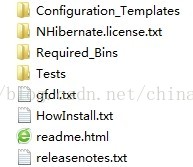NHibernate多对多关联映射的实现
上次用EF演示了数据库多对多关系的操作,这次我们还是引用上次的案例,来演示如何在C#当中使用NHibernate。
首先介绍一下NHibernate框架的来源。熟悉Java编程的读者肯定知道Hibernate这个ORM。NHibernate就来源于Java中著名的ORM框架—Hibernate,这点从名称当中就能够知道。目前NHibernate的最新版本是3.3.3,好像有一阵子没有update了,说明当前的版本也比较稳定了。具体的资料可以到官网查询:http://nhforge.org/。
1、下载NHibernate
官网首页就有下载链接,直接下载就可以了。
下载好之后会得到一个zip包。

我们就地解压可以看到如下目录和文件:

我们重点关注以下目录的内容:
Configuration_Templates目录:默认提供的一些配置模板。有支持Oracle、Sql Server、MySQL等等。
Required_Bins目录:这里面存放了我们开发时常用的dll文件。其中的两个xsd文件是能够提供智能提示的文件,我们需要将它们俩复制到你本地的VS的Schemas目录下,比如我的目录为:D:\Program Files (x86)\Microsoft Visual Studio 11.0\Xml\Schemas 。

复制好之后,重启VS,在我们写Hibernate配置文件时就有了智能提示了。

准备工作做好之后,我们就可以正式演示。
2、创建一个类库项目Model
我们定义好两个类,分别为Student和Subject,为了便于管理,我们将它们放到Entity文件夹里,但命名空间仍为Model。
namespace Model { public enum Gender { Female, Male } public class Student { public virtual int? StudentId { get; set; } public virtual string StudentName { get; set; } public virtual Gender Gender { get; set; } public virtual DateTime? BirthDay { get; set; } public virtual IList<Subject> Subjects { get; set; } } }
namespace Model { public class Subject { public virtual int? SubjectId { get; set; } public virtual string SubjectName { get; set; } public virtual IList<Student> Students { get; set; } } }
这是一个典型的多对多的应用场景。一个学生可以选修多个课程,一个课程可以被多个学生选修。
接下来我们再创建相应的Hibernate配置文件(就是普通的xml文件,取名为Student.hbm.xml和Subject.hbm.xml)。
Student.hbm.xml:
<?xml version="1.0" encoding="utf-8" ?> <hibernate-mapping xmlns="urn:nhibernate-mapping-2.2" assembly="Model" namespace="Model"> <class name="Student" table="T_Student" lazy="true"> <id name="StudentId" type="int" column="StudentId"> <generator class="native"/> </id> <property name="StudentName" type="string" column="StudentName"> <column name="StudentName" length="50"/> </property> <property name="Gender" type="Gender" column="Gender"> <column name="Gender" length="4"/> </property> <property name="BirthDay" type="datetime" column="BirthDay"> <column name="BirthDay" length="20"/> </property> <bag name="Subjects" table="T_Student_Subject"> <key column="StudentId"/> <many-to-many class="Subject" column="SubjectId"/> </bag> </class> </hibernate-mapping>
Subject.hbm.xml:
<?xml version="1.0" encoding="utf-8" ?> <hibernate-mapping xmlns="urn:nhibernate-mapping-2.2" assembly="Model" namespace="Model"> <class name="Subject" table="T_Subject" lazy="true"> <id name="SubjectId" type="int" column="SubjectId"> <generator class="native"/> </id> <property name="SubjectName" type="string"> <column name="SubjectName" length="50"/> </property> <bag name="Students" table="T_Student_Subject"> <key column="SubjectId"/> <many-to-many class="Student" column="StudentId"/> </bag> </class> </hibernate-mapping>
便于管理我们同样的放到Config目录下(自己创建的文件夹)。
同时修改两个xml文件的生成操作由内容变为嵌入的资源(在vs中右键xml文件选择属性)

3、创建一个控制台应用程序
表和实体对应的内容已经定义好,下面关键的就是要写代码来测试NHibernate了,本着尽量降低学习难度的原则,我这里就用控制台应用程序来验证(你也可以新建一个类库项目,然后用VS的单元测试或者第三方测试工具NUnit进行验证)。
首先将下载的开发包里面的Configuration_Templates文件夹下的MSSQL.cfg.xml复制到控制台应用程序中(为方便管理,我新建了一个Config文件夹,并把这个xml文件放到这里面,重命名为hibernate.cfg.xml)。
修改这个xml文件内容为:
<?xml version="1.0" encoding="utf-8"?> <!-- This template was written to work with NHibernate.Test. Copy the template to your NHibernate.Test project folder and rename it in hibernate.cfg.xml and change it for your own use before compile tests in VisualStudio. --> <!-- This is the System.Data.dll provider for SQL Server --> <hibernate-configuration xmlns="urn:nhibernate-configuration-2.2" > <session-factory name="NHibernate.Test"> <property name="connection.driver_class">NHibernate.Driver.SqlClientDriver</property> <property name="connection.connection_string"> Server=.;database=nhibernateTest;uid=sa;pwd=123456; </property> <property name="adonet.batch_size">10</property> <property name="show_sql">true</property> <property name="hbm2ddl.auto">update</property> <property name="dialect">NHibernate.Dialect.MsSql2008Dialect</property> <mapping assembly="Model"/> </session-factory> </hibernate-configuration>
注意这里面的一些节点的配置。比如mapping assembly里面的Model,就是指的是程序集的名称。同时将此文件的复制到输出目录方式修改为始终复制。

接下来,给控制台项目添加两个dll的引用,分别为Iesi.Collections.dll和NHibernate.dll,也是在Required_Bins文件夹里面。
添加好引用,我们创建一个新的类NHibernateTest来写关键性代码。
namespace NHibernateDemo { public class NHibernateTest { private ISessionFactory _sessionFactory; public ISessionFactory SessionFactory { get { if (_sessionFactory == null) { var cfg = new NHibernate.Cfg.Configuration().Configure("Config/hibernate.cfg.xml"); _sessionFactory = cfg.BuildSessionFactory(); } return _sessionFactory; } } public void TestInit() { using (ISession session = SessionFactory.OpenSession()) { IList<Subject> subjects = new List<Subject>() { new Subject { SubjectName = "数学" }, new Subject { SubjectName = "英语" }, new Subject { SubjectName = "计算机" }, }; IList<Student> students = new List<Student>() { new Student { StudentName = "guwei4037", Gender = Gender.Male, BirthDay = new DateTime(1984, 11, 25), Subjects = subjects.Where(x => x.SubjectName == "数学" || x.SubjectName == "计算机").ToArray(), }, new Student { StudentName = "gary.gu", Gender = Gender.Female, BirthDay = new DateTime(1987, 9, 15), Subjects = subjects.Where(x => x.SubjectName == "数学" || x.SubjectName == "英语").ToArray(), }, }; ITransaction tran = session.BeginTransaction(); try { foreach (var subject in subjects) { session.Save(subject); } foreach (var student in students) { session.Save(student); } tran.Commit(); } catch (Exception ex) { tran.Rollback(); throw ex; } } } } }
这是一个带事务的多表插入的操作。
最后在Main方法中,写入简单的调用方法。
public class program { public static void Main(string[] args) { NHibernateTest test = new NHibernateTest(); test.TestInit(); } }
在运行这个程序之前,还要做一件事,就是要在你的Sql Server中新建一个空的数据库nhibernateTest,否则会提示登录失败。
好了,这时我们已经准备好了一切,让我们运行一下这个控制台应用程序吧。
由于我们在hibernate.cfg.xml文件中定义了输入sql,所以会看到窗口中的内容。

好,没有报错。我们打开Sql Server看一下最终的结果。

而且数据库的表、主外键的关联以及数据都为我们自动生成了。
好,双向多对多的关系就演示到这里。如果需要更多详细的信息请参考:http://nhforge.org/doc/nh/en/index.html。


